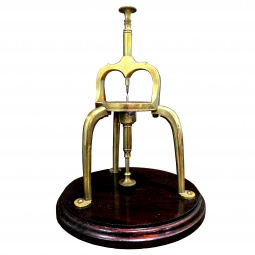Antique Topping Tool aka Rounding Up Tool Watchmaker Tool
ITEM-2247

Product Details
Antique Topping Tool aka
Rounding Up Tool Watchmaker Tool
This watchmaker's tool is a show piece celebrating the history
of watches, and the complexities of making them. It’s a captivating
conversation piece to display on your mantel, and a great way to way to
showcase your love of Horology.
A topping tool from the 1920’s. Predominantly made from bronze,
with a cast iron driving wheel.
Dimensions: Base measures 12" wide, Tool measures 9"
High x 7" Deep.
Topping tools were made to alter (or develop) the profile
of the teeth on wheels. Rarely used today outside of restoration of early
pocket watches or vintage wristwatches.
The tool was made to "top" or round the watch teeth that frequently were cut by a slitting saw and so were flat bottomed and flat topped so the topping tool rounded the tips of the gear teeth to enable correct meshing to occur.
Before the days of standardized machine tooling and cycloidal
gear cutters, watch wheels had to be individually fitted using this tool.
Made from brass, steel and bronze. Measures approximate 12” wide x 9” high x 7” deep
Wheel topping tool,
cutters brass and steel mechanical tool on rectangular wooden base. Large wheel
on right hand side with wooden handle, rotates shaft which then rotates smaller
wheel. Various screws and rods extending from tool. Leather rounding tool
accessories box titled "ACCESSOIRES POUR OUTIL A ARRONDIR" holds
approximately 30 cutters of differing gauge, cordage and 1 metal stakes.
These machines were used for slightly reducing the diameter of and/or truing up wheels which were not running true.
They were also used for shaping the teeth of wheels which were being made. After radial slots had been cut into the outside of a wheel, leaving square-shaped teeth around the circumference, the topping tool, used with appropriate sized and shaped cutter, shaped the ends of the teeth to the correct curvature.
The selected cutter, of the exact shape of the required space between two adjacent teeth, had an adjustable part offset to one side, set so that it entered the space between the next two teeth of the wheel.
With each revolution it pulled the next two teeth of the wheel into position to be shaped. Each revolution of the cutter advanced the wheel by one tooth.
The steel disc in the center is the cutter that files the form of the teeth of the wheel. It is ‘split’ and adjusted, with the lateral steel screw set into the disc, to be able to index the next tooth.

